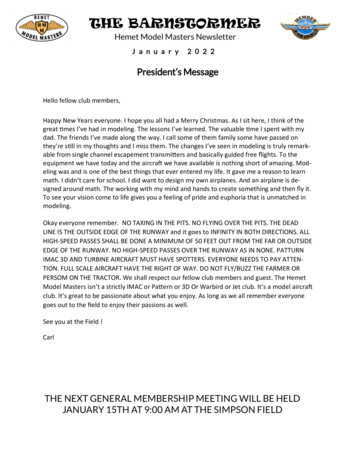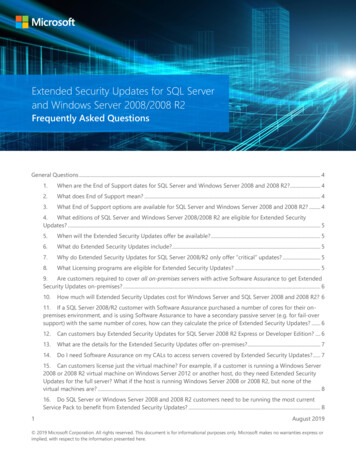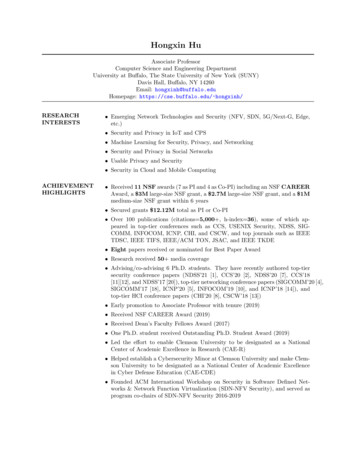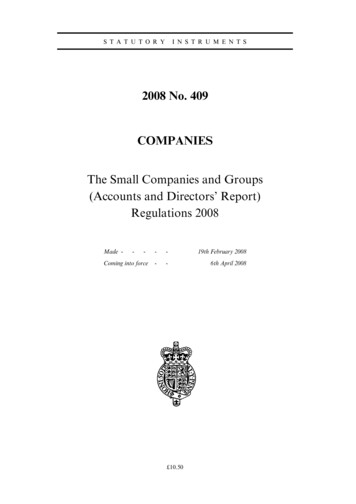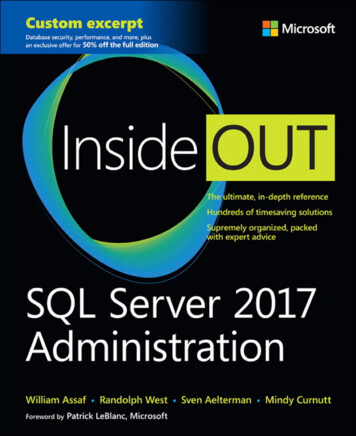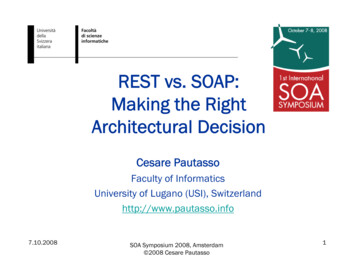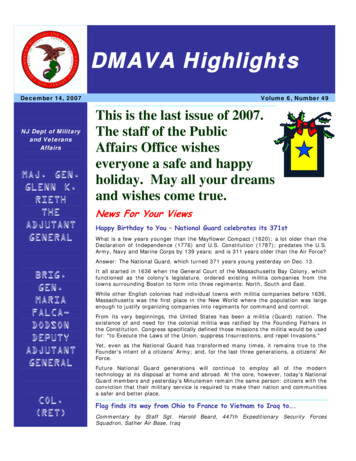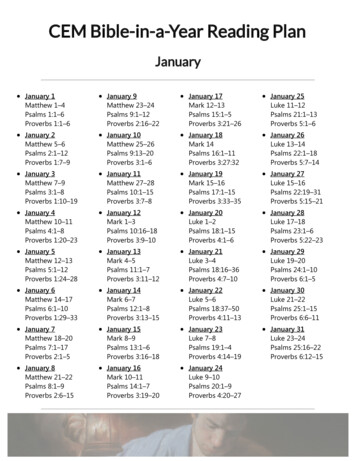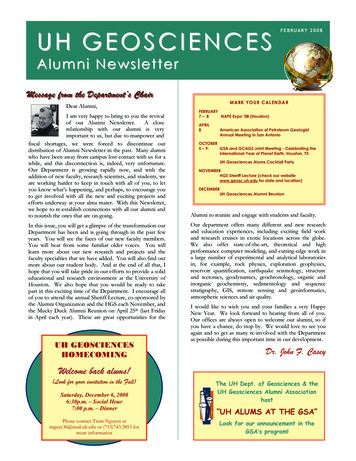
Transcription
UH GEOSCIENCESFEBRUARY 2008Alumni NewsletterMMeessssaaggee ffrroomm tthhee DDeeppaarrttmmeenntt’’ss CChhaaiirrDear Alumni,I am very happy to bring to you the revivalof our Alumni Newsletter.A closerelationship with our alumni is veryimportant to us, but due to manpower andfiscal shortages, we were forced to discontinue ourdistribution of Alumni Newsletter in the past. Many alumniwho have been away from campus lost contact with us for awhile, and this disconnection is, indeed, very unfortunate.Our Department is growing rapidly now, and with theaddition of new faculty, research scientists, and students, weare working harder to keep in touch with all of you, to letyou know what’s happening, and perhaps, to encourage youto get involved with all the new and exciting projects andefforts underway at your alma mater. With this Newsletter,we hope to re-establish connections with all our alumni andto nourish the ones that are on-going.In this issue, you will get a glimpse of the transformation ourDepartment has been and is going through in the past fewyears. You will see the faces of our new faculty members.You will hear from some familiar older voices. You willlearn more about our new research and projects and thefaculty specialties that we have added. You will also find outmore about our student body. And at the end of all that, Ihope that you will take pride in our efforts to provide a solideducational and research environment at the University ofHouston. We also hope that you would be ready to takepart in this exciting time of the Department. I encourage allof you to attend the annual Sheriff Lecture, co-sponsored bythe Alumni Organization and the HGS each November, andthe Mucky Duck Alumni Reunion on April 25th (last Fridayin April each year). These are great opportunities for theUH GEOSCIENCESHOMECOMINGMARK YOUR CALENDARFEBRUARY7– 8NAPE Expo ’08 (Houston)APRIL8American Association of Petroleum GeologistAnnual Meeting in San AntonioOCTOBER5 – 9:GSA and GCAGS Joint Meeting - Celebrating theInternational Year of Planet Earth, Houston, TXUH Geosciences Alums Cocktail PartyNOVEMBERHGS Sheriff Lecture (check our websitewww.geosc.uh.edu for date and location)DECEMBERUH Geosciences Alumni ReunionAlumni to reunite and engage with students and faculty.Our department offers many different and new researchand education experiences, including exciting field workand research cruises in exotic locations across the globe.We also offer state-of-the-art, theoretical and highperformance computer modeling, and cutting-edge work ina large number of experimental and analytical laboratoriesin, for example, rock physics, exploration geophysics,reservoir quantification, earthquake seismology, structureand tectonics, geodynamics, geochronology, organic andinorganic geochemistry, sedimentology and sequencestratigraphy, GIS, remote sensing and geoinformatics,atmospheric sciences and air quality.I would like to wish you and your families a very HappyNew Year. We look forward to hearing from all of you.Our offices are always open to welcome our alumni, so ifyou have a chance, do stop by. We would love to see youagain and to get as many re-involved with the Departmentas possible during this important time in our development.Dr. John F. CaseyWelcome back alums!(Look for your invitation in the Fall)Saturday, December 6, 20086:30p.m. – Social Hour7:00 p.m. – DinnerPlease contact Tram Nguyen attnguye36@mail.uh.edu or (713)743.3853 formore informationThe UH Dept. of Geosciences & theUH Geosciences Alumni Associationhost“UH ALUMS AT THE GSA”Look for our announcement in theGSA’s program!
FACULTY profileJanok Bhattacharya, Professor; Ph.D. 1989 McMasterUniversity, Ontario, Canada. Sequence stratigraphy, deepwater sedimentation.Adry Bissada, Research Professor; Ph.D. 1967 University ofWashington at St. Louis. Petroleum systems, petroleumgeochemistry.Kevin Burke, Professor; Ph.D. 1957 University of London.Global tectonics, basin analysis, rift systems.Daewon Byun, Professor; Ph.D. 1987 North Carolina StateUniversity. Air quality modeling and atmospheric science.Regina Capuano, Associate Professor; Ph.D. 1988University of Arizona.Geochemistry, geohydrology,hydrochemistry.John F. Casey, Professor; Ph.D. 1980 State University ofNew York at Albany. Regional structural geology, platetectonics, igneous petrogenesis, marine geology.John P. Castagna, Professor; Ph.D. 1983 University ofTexas. Seismic analysis, reservoir geophysics, petrophysics.Henry S. Chafetz, Professor; Ph.D. 1970University of Texas. Carbonate ogy.Christina Chan, Visiting Asst. Professor;1999 University of British Columbia. Rockphysics, environmental and engineeringgeophysics.Thomas Lapen, Assistant Professor; Ph.D. 2005 Universityof Wisconsin – Madison. Geochronology, petrology.James Lawrence, Associate Research Professor, Ph.D. 1970California Institute of Technology.geochemistry,meteorology, isotope.Barry Lefer, Assistant Professor; Ph.D. 1997 University ofNew Hampshire. Atmospheric science, global climatechange, air quality modeling and monitoring.Aibing Li, Assistant Professor; Ph.D. 2001 BrownUniveristy.Seismology, synthetic waveform modeling,seismic inversion techniques.Chris Liner, Professor; Ph.D. 1989 Colorado School ofMines. 3D and 4D petroleum seismology, advancedinterpretation methods, desert seismic exploration.Rosalie Maddocks, Professor; Ph.D. 1965 University ofKansas. Paleontology, micropaleontology, ostracodes.Kurt Marfurt, Adjunct Professor; Ph.D. 1978 ColumbiaUniversity. Reflection seismology, seismic modeling and“Personally I’m alwaysreadytolearn,although I do notalwayslikebeingtaught.”Peter Copeland, Associate Professor; Ph.D.1990 State University of New York at Albany.40Ar/39Ar-geochronology, thermochronology, continentaltectonics.John F. Dewey, Distinguished Research Professor; Ph.D.1960 University of London. Structural geology, platetectonics.William R. Dupré, Associate Professor; Ph.D. 1975Stanford University. Sedimentology, fluvial systems.Ian Evans, Associate Professor; Ph.D. 1971 Texas A&MUniversity.Stratigraphy, paleontology, paleomagneticstratigraphy.Gennady Goloshubin, Research Professor; Ph.D. 1981Institute of the Physics of the Earth, Moscow. Reflectionseismology, attribute analysis, reservoir characterizationWinston Churchillinterpretation, physical modeling, seismicattribute analysis, seismic coherency.Michael Murphy, Assistant Professor; Ph.D.2000 University of California at Los Angeles.Structure and tectonics of orogenic belts, faultseal, growth faulting.BernhardRappenglueck,AssociateProfessor; Ph.D. University of Munich.Airchemistry, meteorology.Arch Reid, Professor; Ph.D. 1964 University of Pittsburgh.Igneous petrology, planetary geology, meteorite impacts.Alexander Robinson, Assistant Professor; Ph.D. 2005University of California at Los Angeles. Tectonics.Robert E. Sheriff, Professor Emeritus; Ph.D. 1950 OhioState University.Exploration geophysics, reflectionseismology, seismic stratigraphy, reservoir geophysics.Virginia Sisson, Research Associate Professor; Ph.D. 1985Princeton University. Field-oriented petrotectonic, fluidinclusion, geochemistry.Jonathan Snow, Assistant Professor; Ph.D.WHOI/MIT. Geochemistry, petrology, tectonics.1993Stuart A. Hall, Professor; Ph.D. 1976 University ofNewcastle.Potential fields, paleomagnetics, marinemagnetics, tectonics.Donald Van Nieuwenhuise, Research Associate Professor;Ph.D. 1978 University of South Carolina at Columbia.Clastic depositional systems, high-resolution biostratigraphy.De-hua Han, Research Associate Professor; Ph.D. 1987Stanford University. Rock physics, hydrocarbon fluidproperties, reservoir characterization.Julia Wellner, Visiting Assistant Professor, Ph.D. 2001 RiceUniversity. Sedimentology, glacial.Fred Hilterman, Distinguished Research Professor; Ph.D.1970 Colorado School of Mines. Seismology, seismicinterpretation & analysis, rock physics, AVO, physicalmodeling.Shuhab Khan, Assistant Professor; Ph.D. 2001 Universityof Texas at Dallas. Remote sensing, GIS, tectonics.Robert Wiley, Research Associate Professor, Ph.D. 1980Colorado School of Mines. Geophysical modeling andimaging, seismic, ground water exploration.Hua-wei Zhou, Adjunct Professor; Ph.D. 1989 CaliforniaInstitute of Technology. Earthquake seismology, seismicprocessing, seismic tomography, reflection seismology,seismic inversion, physical and numerical seismic modeling.
FACULTY AccoladesCongratulationsClass of 2007Dr. Kevin Burke is therecipient of the prestigiousPenroseMedalbytheGeological Society of Americain 2007.Geologists fromaroundtheworldareconsidered for the PenroseMedal, which is given foroutstanding achievements inoriginal research. Prior to this,in 2006, Dr. Burke was thehonored recipient of theGeologicalSocietyofAmerica’s Structural Geologyand Tectonics Career AwardsDr. Peter Copeland washonored with the 2007Teaching Excellence Award, anaward by UH Provost Officerecognizingoutstandingfaculty, for teaching in the corecurriculum.Peter wasnominated by students andcolleagues and won the awardwith letters of support such asthat of Nohemi Garcia whowrote about Peter’s class, “Ithought Physical Geology wasgoing to be tedious, but it wasone of the most interestingclasses I have ever taken.”Dr. Janok Bhattacharyareceived the Grover E. MurrayMemorialDistinguishedEducator Award from theAmericanAssociationofPetroleum Geologists in April2007foroutstandingcontributions to geologicaleducation. Janok’s researchfocusesonsequencestratigraphy, and he believesthat, “[our] program crossestheboundariesbetweengeophysics and engineeringdisciplines and provides animportant environment forteamwork and integration thatwe believe provides a modelfor industry.” Prior to thisaward, in 2006, Janok was alsothe recipient of the AmericanAssociation of PetroleumGeologistDistinguishedLecturer’s award.Dr. Fred Hilterman was thehonored recipient of the 2006Maurice Ewing Medal from theSocietyofExplorationGeophysicists (SEG).Thehighest honor given by SEG,the Ewing Medal extendsspecial recognition to majorcontributions to advancing thescience and profession ofexploration geophysics.Dr. John F. Dewey receivedthe Structure and TectonicsCareer Contribution Awardfrom the Geological Society ofAmerica for his contributionsto the science of structuralgeology and tectonics.Dr. Kurt Marfurt was chosenby SEG to teach its 2006Distinguished Instructor ShortCourse (DISC). Selection asthe DISC instructor is regardedas a recognition of excellenceby SEG.Dr. William Dupré washonored with the 2007 John C.Butler Teaching Award formaking a difference in theclassroom and connecting withstudents. The award, namedafter our own John C. Butler(1941-2001) who always lookedfor a better way to teach andmake students look at thingsdifferently.The award istypically awarded to one facultymember, but this year, theselection committee had twonominees with long-trackrecords of engaging studentsand sharing their enthusiasmfor the subject matter theyteach.Dr. John Castagna was therecipient of the 2006 Society ofExplorationGeophysicistReginald Fessenden Award. Theaward is given as specialrecognition to individual andorganizationfortheircontribution to geophysics andto the Society of ExplorationGeophysicists.Bachelor of Arts or SciencesAyman Aboshihata, GeophysicsPeggy Alderman, Earth ScienceRitesh Bhakta, GeologyFelicia Bryan, Earth ScienceBryan Cardner, GeologyAmy Chitwood, Earth ScienceRichard Fuller, GeologyKhaled Ghuneim, GeophysicsGarrett Meshyba, GeophysicsBeryl Onakpoya, Environtal ScienceMatthew Orillion, GeologyCelicia Ramirez, GeophysicsCyrus Sefidrou, GeophysicsSteven Tessari, GeophysicsZachary Wolfe, GeologyKelly Zuniaga, GeologyMaster of Art or SciencesOlufemi Akanbi, GeophysicsOyetayo Akintokunbo, GeologyMary Canino, GeologyArindam Chakraborty, GeologyMorenike Coker, GeologyKatrina Cox, GeologyJana Gray, GeologyDouglas Hinkle, GeologyJames Lawrence, GeologyRonald Mart, GeologyJose Omana, GeophysicsVeronica Sanchez, GeologyTimothy Chapman, GeophysicsMingya Chen, GeophysicsChing-Wen Chen, GeophysicsMilos Cvetkovic, GeophysicsTaeHyeong Lee, GeophysicsRyan Perna, GeophysicsDoctor of PhilosophyTathagata Banga, GeologyNeda Bundalo, GeophysicsCraig Clements, GeophysicsVioleta Coarfa, GeophysicsDiana Dragoi, GeophysicsLi Li, GeophysicsLong Ma, GeologyGabriel Perez, GeophysicsBo Zhao, Geophysics“Any intelligent fool canmake things bigger, morecomplex, and more violent.It takes a touch of genius– and a lot of courage – tomove in the oppositedirection.”Albert Einstein
BUILDING blocksThe number of researches in the Department of Geosciences continued to increase, and our faculty haswon a number of grants and donations from various public and private organizations to support theirinnovations. Follows is a summary of the grant/support awarded to our faculty in FY 2007 & 2008.Dr. Aibing Li was awarded the FacultyEarly Career Development from theNational Science Foundation.Protection Agency to support theirresearch in the Characterization of EasternTexas Air Quality.Harvard University for his study titled“Global Change and Air Pollution: Phase2 Implications.”Drs. Michael Murphy, Thomas Lapenand Alex Robinson received supportfrom the NSF for their research titled,“Investigation of the Deformation Historyof the India-Asia Suture Zone,Lopukangri, South Central Tibet.Dr. Daewon Byun received support fromthe Texas Commission on EnvironmentalQuality for his research titled “ImprovedModeling Inputs: Land Use and SeaSurface Temperature.”Dr. John Castagna received a grant fromG&W, Inc. which funds his research inImproved Spectral Inversion of SeismicDataUsingMatchingPursuitDecomposition Algorithm.Drs. James Lawrence and RosalieMaddocks received support from theHouston Coastal Center for their researchin Climate Changes in the Tropics usingStable Isotopes.Dr. Hua-wei Zhou received grant fromthe National Science Foundation tosupport his research titled “SeismicImaging of Southern California CrustUsing Deformable-Layer Tomography &Prestack Depth.Dr. Janok Bhattacharya receivedsupport for his research in Dr. Aibing Li received grant from theNational Science Foundation to supporther research titled “Integrating SeismicConstraint on Continental Upper Mantle.”Drs. Jonathan Snow and ThomasLapen received a grant from NSF tosupport their research titled “Os, Nd andHf Isotopes in Abyssal Periodotites fromArctic Lena Trough.”Dr. De-hua Han received supports fromvarious private organizations to supporthis research in Fluid & Rock Propertiesand Seismic Hydrocarbon Indicators.Dr. Barry Lefer received a grant from theUS Environmental Protection Agency tosupport his research entitled “The Impactof Aerosis, Clouds and Ozone.”Dr. Daewon Byun received grants fromthe Korean Environment Institute to fundfor his research in “Application of theEmissions Inventory Preparation Systemwith the CAPSS and Estimation ofBiogenic.”Drs. Barry Lefer, Daewon Byun, andBernhard Rappenglueck received agrant from the US Environmental“If we knew what it was we were doing, it would not becalled research, would it?”Albert EinsteinDr. Shuhab Khan received grant fromthe Western Michigan University tosupport his research in Assessment &Development of Renewable GroundwaterResources in the Quetta Valley, Pakistan.Dr. Barry Lefer received a grant fromthe National Science Foundation for hiscollaborative research titled “RadicalChemistry Over Sunlit Snow at Summit,Greenland.”Drs. Daewon Byun and BernhardRappenglueck received support for theirresearch “Multi-resolution Simulation andAnalysis of TexAQSII Air PollutionEvents” from the Houston AdvancedResearch Center.Dr. Daewon Byun received grant fromthe Texas Commission on EnvironmentalQuality to support the Galveston BayEstuary Program.Drs. Bernhard Rappenglueck, DaewonByun and Barry Lefer received grantfrom the Texas Commission onEnvironmental Quality to support theircollaborative research titled “DataAnalysis of Air Pollution Measurementsfrom Summer 2006 and Preparation ofModel Input.”Dr. Julia Wellner received support fromRice University to fund her collaborativeresearch titled “Controls on SedimentYields from Tidewater Glaciers fromPatagonia to Antarctica.”Dr. Hua-wei Zhou received supportfrom the China National PetroleumCorporation for his research inDevelopment of Expertise in Land andMarine Exploration Geophysics.Drs. Barry Lefer and BernhardRappenglueck received a grant from theHouston Advanced Research Center tofund for their study in TRAMP DataAnalysis and Radical Chemistry Study.Dr. Daewon Byun received support fromDr. Bernhard Rappenglueck receivedsupport from Baylor University at Wacoin support of his program “VOC CanisterSampling.” want to keep up with thefast pace of today’sscientific world?WEEKLY SEMINARSThe Department ofGeosciences hosts weeklyseminars presenting the mostinnovative scientists with theirbreakthrough researches.Admission is free. Social hourto follow the presentation.For more information, visit ourwebsite:www.geosc.uh.edu
the investigatorsScientific research is main-frame for any higher learning institute. Our department is apremier research institute for earth, energy and environmentally related sciences. Ineach issue of the Alumni Newsletter, we hope to bring you the newest developmentsthat our faculty and students had discovered in their scientific pursuits.INSTITUTE OF MULTI-DIMENSIONAL AIR QUALITY SYSTEM (IMAQS)Dr. Barry Lefer, an IMAQS faculty member, and his group has been focusing ona few different projects. The first is analysis photochemical ozone productionduring the Texas air Quality Study (TexAQS-II) using data collected on roof ofthe UH-Moody Towers (Aug – Oct 2006). Master’s student James Flynnpresented results from this project at the 2007 AGU (Impact of clouds andaerosols on ozone photochemistry during the TexAQS-II Radical MeasurementProject). And Master’s student Monica Patel will present a paper at the 2008American Meteorological Society meeting on her investigation of “The Effect ofLocal Circulations on Ozone Transport in the Houston-Galveston Area duringTexAQS-II”. Ph.D. student, Christine Haman, is working on UV and VIS solarradiation measurements from above and within the Greenland snowpack in thesummer of 2007. Christine and Barry Lefer will spend a total of 7 weeks at theSummit Greenland Ice Camp collecting more snowpack solar radiation data toinvestigate the rates of photochemical radical formation and the importance ofsnow halogen chemistry at this remote high altitude site. For more informationregarding the Lefer’s group research, visit the following .com“When science finally locates thecenter of the universe, some peoplewill be surprised to learn they’re notit.”Bernard BaileyIN THE NAME OF SCIENCE: Dr. Mike Murphy,suffering from intense butt-sore, tried to carry onwith his research in Zada Basin in Western Tibet.Satellite camp about a kilometer southof the Summit Ice Camp where thescienceteamstayswarmwhileinvestigating snow photochemistry.Cloud camp photo during TexAQS-IIcampaign. Digital photos of the skywere taken each minute to estimatepercent cloud cover. Data will be usedto evaluate atmospheric models ofcloud formation, a key variable inforecasting Houston air quality.INVESTIGATION OF THE DEFORMATION HISTORY OF THE INDIA-ASIACOLLISION ZONE, SOUTHERN TIBETDrs. Michael Murphy, Tom Lapen, and Alex Robinson – co-investigatorsProject funded by the NSFThe Tibet-Himalayan orogen is a paradigm for active intercontinentalcollision; hence studies of its evolution have played a major role in shapingour conceptual understanding of mountain-building processes andcontinental growth by accretion. Numerous geodynamic models oforogenesis have emerged from geologic and geophysical studies of theTibet-Himalayan orogen, however, their ability to predict the behavior ofmiddle and lower crust remain largely untested. This is because access todeep rocks in the orogen is, in general, limited to the frontal regions in theHigh Himalaya. Hypotheses advanced to explain the history of these rockscall upon processes which link them to the suture zone between India andAsia. During a reconnaissance investigation in the summer of 2006,University of Houston faculty identified a region that provides a windowinto the deep structure of the India-Asia suture zone. This project employsnovel techniques in isotope geochemistry, geochronology, and mapping ofthe Earth’s surface to address poorly understood processes hypothesized tooperate during intercontinental collision, such as, the deep structure ofsuture zones, and the rates at which suture zone rocks are translated fromgreat depths to the surface. Integration and analysis of these newobservations with existing geologic and geophysical data from other partsof the Himalaya and Tibet will significantly impact our conceptualunderstanding of the evolution of mountains belts and continents.
in their own words Hi all,Some of you will probably be surprised to see that I’m stillhere, in fact, in the exact same office since 1970. As theysay, some things never change. Teaching has changedsomewhat, although I still teach microscope courses(carbonates and sandstones) and carbonate sedimentology, all at graduatelevel. I’m also teaching a junior-level course in sedimentary petrogenesis.The department felt we needed more on soft-rock at the undergrad level.Of course, presentation of lecture material in all classes is dominantly byPowerPoint these days.As usual, graduate students working with me are involved in a diversearray of soft-rock studies. Penny Taylor (presently on staff at Mt. Holyokein Massachusetts) is very close to finishing her Ph.D. study on carbonateprecipitation in caves in central Texas, anticipate that she will wrap that upJim Strasen and Long Ma approaching oolite bar, Bighornby mid-Spring. She published part of it in JSR in 2004. Have a look,some neat stuff! Jim Strasen, also Ph.D. candidate, is also essentiallydone. He has been studying the deposition of the Jurassic Sundance Fmin the Bighorn Basin of Wyoming, fantastic field area, and beautifulexposures in wide open country.Maggie and Megan near top of tufa mound, Searles Lake, CaliforniaWhen Jim was not around the office, you knew he made another trip tolook at rocks. I think about 9 trips in all. In addition to his extensivefield work, he has done some really incredible things with remotesensing, being able to distinguish different carbonate outcrops 10m x10m in size using an array of different bands of satellite data. Jie Zhou(Ph.D.) is in the initial stages of writing, studying differences in calicheacross the state of Texas, from humid east Texas to arid west Texas. Hehas found some very interesting stable isotopic trends across the state aswell as differences within modern caliches from the same soil horizons. Sushanta Bose has worked on different subtle sedimentarystructures that form as a result of the interaction of microbial mats and siliciclastics sediments, such as on the bayward side ofGalveston Island. He presented some of his findings at an HGS meeting and received Best Poster award, and has given a talk onthis subject at an international Precambrian conference in India. Sushanta anticipates finishing his Ph.D. this Spring or Summer.Those four Ph.D. candidates should all graduate within the year, all with jobs. Xuan (Maggie) Guo has completed her first field tripto an incredible collection of Quaternary age lacustrine tufa mounds (up to 40m high) in Searles Lake, California (near Death Valley).She presented a very well-received talk at the last GSA in Denver (2007) about these mounds. Although logistically the mounds areeasy to get to, roads right into the midst of the area, they present some interesting problems. We were out there collecting samplesthis summer when it hit 128oF in Baker, a nearby town. It was so hot on the outcrop that the glue holding the soles of both of myfield boots literally melted and the soles came off. Heck, they were old boots anyway. Of course, the lesson: always carry duct tapein the field. The geology is worth it, and Maggie has already made some brand new discovery, e.g., some of the tufa is aragonite.And lastly, but of course not leastly, Magen Brock Casillas has just begun sampling for her M.S. thesis along Padre Island. She willbe studying the break down of the shells comprising Big Shell and Little Shell beaches as well as studying their Pleistocene analogalong Laguna Madre, where beds of similar shell hash occur as beds of well-lithified fossiliferous limestone, i.e., biosparite beachdeposits.As for my own work, as of late, I have been sampling some Mn-rich hot spring deposits in Yellowstone. Naturally, they arebacterially induced precipitates. Big story with these deposits is that the bacterially induced Mn-precipitates all have very highoxidation states, that is, the Mn is close to 4, whereas abiotic Mn-precipitates have considerably lower oxidation states. In samplesin which the bacterial bodies have decayed, this knowledge about oxidation state may allow us to distinguish bacterially induced fromabiotic precipitates, such as in samples from Mars. That is the Mn oxidation state may be a biotic signature. Yellowstone has beensuch a neat and fruitful place to work.On a personal note, Janet (my wife of 37 years) passed away during the summer of 2006 from cancer. On a happier note, our sonJosh got his B.A. from Yale (2001), was a Rhodes Scholar and received his M.Phil and D. Phil from Oxford (2004), then a lawdegree from Yale (2007), and is presently a clerk for the Federal Appellate Court of Second Circuit (New York City). Obviously, thebest piece of scholarship Janet and I produced.In closing, I would definitely encourage you to visit us either in the department and/or in late Spring at our annual alumni gettogether at the Mucky Duck.Hank Chafetz
Most of my time over the past few yearsappears to be devoted to teaching. Isuppose it has been time well-spent, as I wasawarded the John C. Butler TeachingExcellence award for the college last year.John was a wonderful mentor, and Icouldn’t be more proud! Recent coursesinclude the perennial Physical Geology, both face-to-face andonline, Environmental Geology (on loan from Hank Chafetz),Geology of National Parks (my personal favorite), andTerrigenous Depositional Systems (both for our regulargraduate students and for our accelerated master’s program).I’m no longer teaching field camp, however, a brief visit withthe group to Utah last summer has rekindled my interest infield camp. Who knows what’s in store for me next summer!I also had a chance to give a semester-long workshop forHISD teachers on “Living with Geologic Hazards,” and giveinvited lectures at the Museum of Fine Arts on “The Influenceof geology on artists of the American West” and at a recentGIS conference entitled, “Where was GIS when I needed it?”Variety is the spice of life I am also pleased to report some success in supervisinggraduate students. Recent master’s graduates include SonyaPunch (Eocene sedimentary rocks in Trinidad and Barbados),Chris Angel (Pleistocene sediments in Texas), Yomi Oyudele(Pleistocene sediments offshore Texas), and Doug Hinkle(fluvial processes along the Trinity River). Ugo Oduma(Oligocene sedimentary rocks near Huntsville) is busily tryingto join that group of recently graduated students. Her posterwon first prize at a recent HGS meeting, so she is clearly wellon her way as well.When I’m not teaching or supervising graduate students, mytime seems mostly to be spent advising undergraduates, as Iam now (once again) the undergraduate advisor for geology,geophysics, and earth science students. Our enrollment hasdoubled in the last couple of years. However, we have a wayto go before we see the crazy days and huge enrollments of thelate 1970’s and early 80’s.I continued to be somewhat active in the Houston GeologicalSociety, However, I’ve recently finished my third two-year stinton the Board of Directors, and will probably try to avoidelective office for a few years.On a personal note, my wife Elaine and I are traveling morenow that our two boys are on their own (though both arepresently in law school). A pending trip to the Galapagos thissummer may be the highlight of next year’s letter!Bill DupréI continue to teach Stratigraphy and Physical Geology at undergraduate level and Tectonics& Sedimentation for graduate students. Since Janok Bhattacharya joined the faculty wehave initiated a switch off in teaching stratigraphy. Because of this, Dr. Maddocks and I arenow able to alternate teaching paleontology. Since early in the 21st century, I have goneover to the dark side, becoming the Associate Dean for Undergraduate Affairs (at thebehest of the late, and much missed, John Butler). This is a job that absorbs unbelievableamounts of time at different times in the academic year.Ian EvansI teach paleobiology, oceanography andhistorical geology and conduct research onOstracoda.Since 2002 I have beenSecretary-General of the eo.ku.edu). I am now Editor forOstracoda for “Zootaxa; a rapidinternational journal for ecent papers are listed below, and thespecies list in the Gulf of Mexicovolume is predicted to appear soon.The figure here shows Thomontocyprisbrightae Maddocks, 2006, which wascollected from washings of giant tubeworms at Riftia Field on the East Pacific Rise, Latitude9o50.705’N, Longitude 104o17.493’W, depth 2,500m.2005. Maddocks, Rosalie F. Ostracoda Podocopida, p. 106-128.In, P.A. McLaughlin and D.K. Camp, eds., Common andScientific Names of Aquatic Invertebrates from the United Statesand Canada: Crustaceans.Special Publication 31:1-545
educational and research environment at the University of Houston. We also hope that you would be ready to take . Regional structural geology, plate tectonics, igneous petrogenesis, marine geology. . Ph.D. 1964 University of Pittsburgh. Igneous petrology, planetary geology, meteorite impacts. Alexander Robinson, Assistant Professor; Ph.D. 2005


